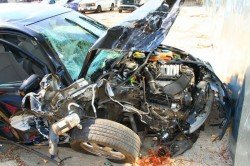EPA’s new CAFÉ mileage standards kill
Strengthening CAFÉ standards by 53.5 percent by 2025 likely will yield deadlier cars. Airbags will do only so much while surrounded by materials that recall aluminum or vinyl siding. “CAFÉ kills, and higher CAFÉ standards kill even more.”

By Deroy Murdock
Washington taxes and regulations keep yanking money from Americans’ wallets. Now EPA is preparing to make prices for cars and light trucks rise beyond the reach of low-income drivers. That’s bad enough. But from there, things grow deadly.
At fault is a regulatory regime known as Corporate Average Fuel Economy, and commonly called CAFÉ standards. Congress mandated these mileage rules in 1975, during a seemingly decade-long energy crisis. Washington has periodically hiked CAFÉ standards in an ongoing effort to boost automobile efficiency.
Lacking magic wands, car manufacturers spend money to obey these laws. And then – surprise! – up go sticker prices. Now EPA is using its self-proclaimed authority over carbon dioxide to justify tough new mileage standards, on the ground that they will reduce global warming and thus improve human health and welfare.
The National Automobile Dealers Association calculated on April 12 that a Chevrolet Aveo, the most affordable vehicle it studied, would climb from $12,700 to $15,700 by 2025, because of the rules. This $3,000 hike (in 2010 dollars, and without factoring in the costs of carrying a three to five-year loan) would prevent 6.8 million humble drivers from qualifying for loans to finance their purchases.
“Fuel economy improvements must be affordable,” New Mexico Ford dealer Don Chalmers told journalists at the estimate’s unveiling. “If my customers can’t buy what I’ve got to sell, there are no savings at the gas pump and there is no environmental benefit.”
Is this what Environmental Protection Agency chief Lisa Jackson calls “environmental justice?”
Team Obama is fueling these anticipated price hikes by boosting CAFÉ standards from 35.5 miles per gallon in 2016 to 54.5 MPG by 2025.
As they have for 37 years, car companies will follow these new rules by making cars thinner and lighter, and made more from plastic and aluminum than from crash-resistant steel. Smaller, slighter vehicles get better mileage. But that hardly matters when a car smacks into a sycamore or cement wall, tumbles down a slope, or slams head-on into another vehicle.
That’s when even the most eco-conscious drivers would trade lower MPG for protective layers of thick steel. That’s real health and welfare.
The laws of physics are stubbornly impervious to Obama’s green slogans, no matter how abrasively he shouts them. (And note that the President and many Administration officials get chauffeured around in big limousines that are anything but low-mileage.) The Insurance Institute for Highway Safety concluded in 2007 that “None of the 15 vehicles with the lowest driver death rates is a small model. In contrast, 11 of the 16 vehicles with the highest death rates are mini or small models.”
“Fuel-standard lethality is as obvious as a smashed windshield,” J.R. Dunn observed in The American Thinker. He chillingly has detailed the mayhem that CAFÉ standards have unleashed.
According to the Brookings Institution, a 500-lb weight reduction of the average car increased annual highway fatalities by 2,200-3,900 and serious injuries by 11,000 and 19,500 per year. USA Today found that 7,700 deaths occurred for every mile per gallon gained in fuel economy standards. Smaller cars accounted for up to 12,144 deaths in 1997, 37% of all vehicle fatalities for that year.
How many deaths have resulted? Depending on which study you choose, the total ranges from 41,600 to 124,800. To that figure we can add between 352,000 and 624,000 people suffering serious injuries, including being crippled for life. In the past thirty years, fuel standards have become one of the major causes of death and misery in the United States — and one almost completely attributable to human stupidity and shortsightedness.
Focus briefly on the tears and tombstones behind these casualty figures. Most of these injuries involved major pain and hardship. Nearly each one of these CAFÉ-caused deaths featured crying loved ones, a casket, and someone inside it who probably made people smile just days earlier.
The only good news here is that road deaths have fallen lately, but for other reasons.
Says Dr. Soumi Eachempati, Chief of Trauma Services at Manhattan’s Weill Cornell Medical Center: “I feel the recent decreases in fatality data are due to many safety measures including better airbags, more states having seat belt laws, higher seat belt compliance, more strict drunk driving laws, better trauma care, better EMS, more traffic congestion in certain areas, and what  some feel are safer road conditions.”
some feel are safer road conditions.”
But rather than leave bad enough alone, Obama and company clamp down, ever harder. Strengthening CAFÉ standards by 53.5 percent by 2025 likely will yield deadlier cars. Airbags will do only so much while surrounded by materials that recall aluminum or vinyl siding.
Before Washington sends additional Americans to early graves, Team Obama should step off the gas pedal and ponder the physicist who wrote Traffic Safety. Dr. Leonard Evans was perfectly clear: “CAFÉ kills, and higher CAFÉ standards kill even more.”
______________
 New York commentator Deroy Murdock is a nationally syndicated columnist with the Scripps Howard News Service and a media fellow with the Hoover Institution on War, Revolution and Peace at Stanford University. A version of this article originally appeared on National Review Online.
New York commentator Deroy Murdock is a nationally syndicated columnist with the Scripps Howard News Service and a media fellow with the Hoover Institution on War, Revolution and Peace at Stanford University. A version of this article originally appeared on National Review Online.
Help Make A Difference By Sharing These Articles On Facebook, Twitter And Elsewhere:
